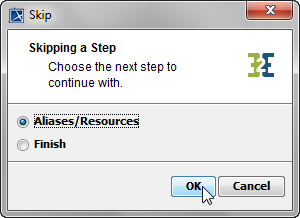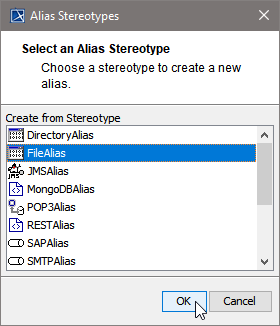...
- Assigning the Diagram Name
- Defining the Composite
- Defining the Frontend Service
- Defining the SOAP Service Interface
- Defining Backend Aliases
- Finishing the Components Wizard
Step 1: Assigning the Diagram Name
After starting the Components Wizard, the first dialog opens, and you are prompted to enter the name of the component diagram.
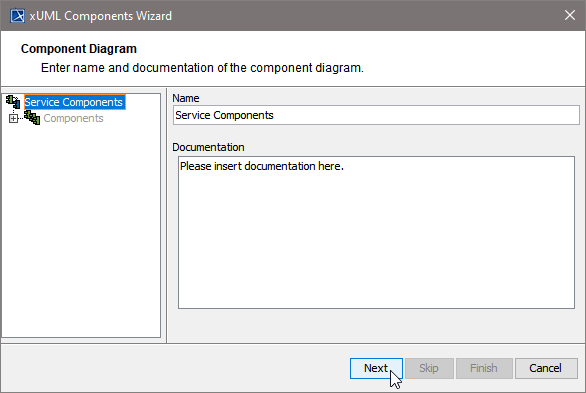 Image Modified Image Modified
| You may use the suggested default name name suggested or enter a descriptive name. Changing the name will change the name of the top most tree node (marked in blue) in the navigation panel. Click Next to proceed or Cancel to abort. |
The Components Wizard can be canceled any time.
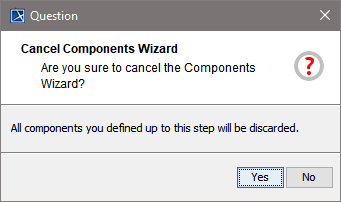 Image Modified Image Modified
| After clicking cancel, the Components Wizard prompts for confirmation. |
Step 2: Defining the Composite
In With the next step, you will define the service composite. The service composite represents the repository of the Web service and will contain all necessary configuration information.
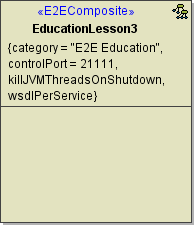
Clicking Next after assigning having assigned the diagram name will bring you directly to the following dialog. Create the service composite here.
 Image Modified Image Modified
| Assign a name to the composite. In the field Control Port, enter an unused port number (the value needs to be between 20'000 and 29'999). | Note |
|---|
icon| Info |
|---|
| false | Special characters and blanks are not allowed for composite names. |
|
 Image Modified Image Modified
| In case you accidentally clicked the Cancel button was accidentally pressed, the Create new Composite window can be re-opened by clicking the New button. |
The Create New Composite dialog contains four more tabs.
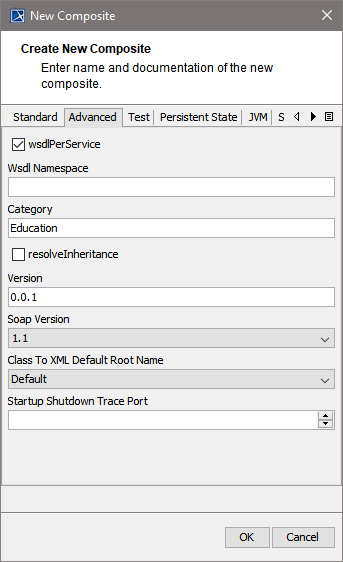 Image Modified Image Modified
| On the Advanced tab of this dialog, you can
Bridge 7 Using this option is deprecated.Bridge 7 specify a service version
This service version will be visible in service context on the Bridge.select the SOAP version of the servicespecify a startup shutdown trace portadvanced composite settings as tagged values to the composite. | Tagged Value | Description |
|---|
| wsdlPerService | | Multiexcerpt include |
|---|
| MultiExcerptName | wsdlPerService |
|---|
| nopanel | true |
|---|
| PageWithExcerpt | Frontend Components |
|---|
|
| | WSDL Namespace | | Multiexcerpt include |
|---|
| MultiExcerptName | wsdlNamespace |
|---|
| nopanel | true |
|---|
| PageWithExcerpt | Frontend Components |
|---|
|
| | Category | | Multiexcerpt include |
|---|
| MultiExcerptName | category |
|---|
| nopanel | true |
|---|
| PageWithExcerpt | Frontend Components |
|---|
|
| | resolveInheritance | | Multiexcerpt include |
|---|
| MultiExcerptName | resolveInheritance |
|---|
| nopanel | true |
|---|
| PageWithExcerpt | Frontend Components |
|---|
|
| | Version | | Multiexcerpt include |
|---|
| MultiExcerptName | version |
|---|
| nopanel | true |
|---|
| PageWithExcerpt | Frontend Components |
|---|
|
| | Soap Version | | Multiexcerpt include |
|---|
| MultiExcerptName | soapVersion |
|---|
| nopanel | true |
|---|
| PageWithExcerpt | Frontend Components |
|---|
|
| | Class To XML Default Root Name | | Multiexcerpt include |
|---|
| MultiExcerptName | classToXMLDefaultRootName |
|---|
| nopanel | true |
|---|
| PageWithExcerpt | Frontend Components |
|---|
|
Refer to XML - UML Class Mapping for more information on the topic of XML serialization. | | Startup Shutdown Trace Port | | Multiexcerpt include |
|---|
| MultiExcerptName | startupShutdownTracePort |
|---|
| nopanel | true |
|---|
| PageWithExcerpt | Frontend Components |
|---|
|
|
For more information on these tagged values refer to Frontend Components . |
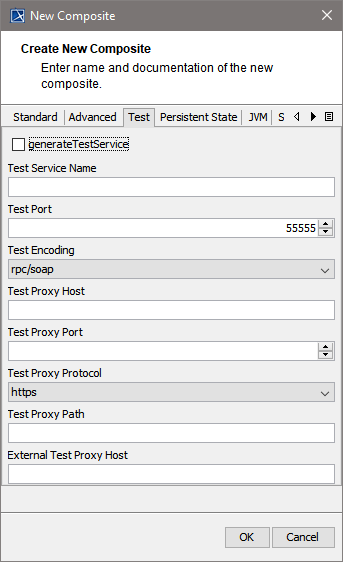 Image Modified Image Modified
| Specify the test settings here. | Tagged Value | Description |
|---|
generateTestService |
| | Multiexcerpt include |
|---|
| MultiExcerptName | generateTestService |
|---|
| nopanel | true |
|---|
| PageWithExcerpt | Using Testable Classes |
|---|
|
| Test Service Name |
| | Multiexcerpt include |
|---|
| MultiExcerptName | testServiceName |
|---|
| nopanel | true |
|---|
| PageWithExcerpt | Using Testable Classes |
|---|
|
| | Test Port |
| | Multiexcerpt include |
|---|
| MultiExcerptName | testPort |
|---|
| nopanel | true |
|---|
| PageWithExcerpt | Using Testable Classes |
|---|
|
| Test Encoding |
| | Multiexcerpt include |
|---|
| MultiExcerptName | testEncoding |
|---|
| nopanel | true |
|---|
| PageWithExcerpt | Using Testable Classes |
|---|
|
| Test Proxy Host |
| | Multiexcerpt include |
|---|
| MultiExcerptName | testProxyHost |
|---|
| nopanel | true |
|---|
| PageWithExcerpt | Using Testable Classes |
|---|
|
| | Test Proxy Port |
| | Multiexcerpt include |
|---|
| MultiExcerptName | testProxyPort |
|---|
| nopanel | true |
|---|
| PageWithExcerpt | Using Testable Classes |
|---|
|
| | Test Proxy Protocol |
| | Multiexcerpt include |
|---|
| MultiExcerptName | testProxyProtocol |
|---|
| nopanel | true |
|---|
| PageWithExcerpt | Using Testable Classes |
|---|
|
| | Test Proxy Path |
| | Multiexcerpt include |
|---|
| MultiExcerptName | testProxyPath |
|---|
| nopanel | true |
|---|
| PageWithExcerpt | Using Testable Classes |
|---|
|
| | External Test Proxy Host |
| | Multiexcerpt include |
|---|
| MultiExcerptName | externalTestProxyHost |
|---|
| nopanel | true |
|---|
| PageWithExcerpt | Using Testable Classes |
|---|
|
|
For more information on testing in general refer to QA Concepts. |
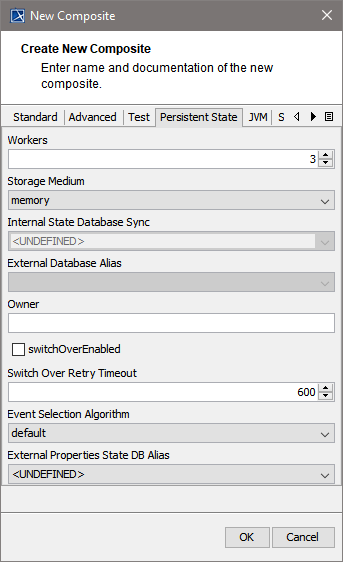 Image Modified Image Modified
| Using Persistent State features in the xUML service, you can make corresponding adjustments on the Persistent State tab configuring , and configure the persistent state engine. | Tagged Value | Description |
|---|
| Workers | | Multiexcerpt include |
|---|
| MultiExcerptName | workers |
|---|
| nopanel | true |
|---|
| PageWithExcerpt | Persistent State Components |
|---|
|
| | Storage Medium | | Multiexcerpt include |
|---|
| MultiExcerptName | storageMedium |
|---|
| nopanel | true |
|---|
| PageWithExcerpt | Persistent State Components |
|---|
|
| | Internal State Database Sync | | Multiexcerpt include |
|---|
| MultiExcerptName | state_db_synch |
|---|
| nopanel | true |
|---|
| PageWithExcerpt | Persistent State Components |
|---|
|
| | External Database Alias | | Multiexcerpt include |
|---|
| MultiExcerptName | externalStateDBAlias |
|---|
| nopanel | true |
|---|
| PageWithExcerpt | Persistent State Components |
|---|
|
| | Owner | Owner specifies the owner of the persistent state objects. Default owner (used when no divergent owner is specified) is the xUML service name, which is unique on each node instance. | | Switch Over Enabled | | Multiexcerpt include |
|---|
| MultiExcerptName | switchOverRetryTimeout |
|---|
| nopanel | true |
|---|
| PageWithExcerpt | Persistent State Components |
|---|
|
| | Switch Over Retry Timeout | | Multiexcerpt include |
|---|
| MultiExcerptName | switchOverEnabled |
|---|
| nopanel | true |
|---|
| PageWithExcerpt | Persistent State Components |
|---|
|
| | Event Selection Algorithm | |
| event_selection_algorithm |
|---|
| nopanel | true |
|---|
| PageWithExcerpt | Persistent State Components |
|---|
|
| | External Properties State DB Alias | | Multiexcerpt include |
|---|
| MultiExcerptName | externalPropertiesStateDBAlias |
|---|
|
|
| | nopanel | true |
|---|
| PageWithExcerpt | Persistent State Components |
|---|
|
|
For more information Persistent State Components. |
 Image Modified Image Modified
| Using Java services in the xUML service, you can specify the JVM options here. | Tagged Value | Description |
|---|
JVM Options |
| | Multiexcerpt include |
|---|
| MultiExcerptName | jvmOptions |
|---|
| nopanel | true |
|---|
| PageWithExcerpt | Modeling the Java Components |
|---|
|
| | killJVMThreadsOnShutdown |
| | Multiexcerpt include |
|---|
| MultiExcerptName | killJVMThreadsOnShutdown |
|---|
| nopanel | true |
|---|
| PageWithExcerpt | Modeling the Java Components |
|---|
|
| | Parallel JVM Operations |
| | Multiexcerpt include |
|---|
| MultiExcerptName | parallelJVMOperations |
|---|
| nopanel | true |
|---|
| PageWithExcerpt | Modeling the Java Components |
|---|
|
|
For more information on Java Components refer to Modeling the Java Components. |
...
Up to this point, you have defined the xUML service component EducationLesson3.
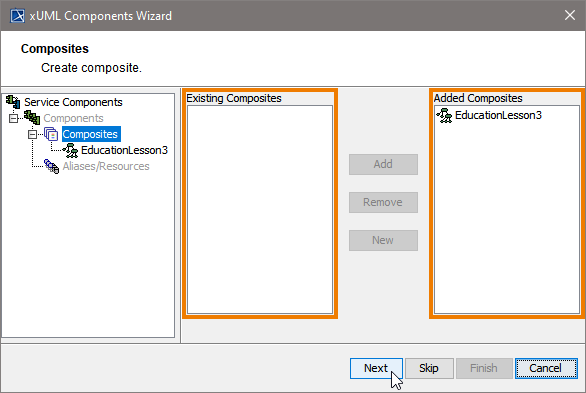 Image Modified Image Modified
| In the customization panel, you will can find the new xUML service component (e.g. EducationLesson3) in the list of added composites on the right side. | Info |
|---|
| The left side of the customization panel contains available components, classes, or interfaces. The right side always contains the used components. |
|
Click Next to proceed.
Step 3: Defining the Frontend Service
In the next step, you define the frontend service that will be part of the xUML service.
...
Clicking Next after having defined the composite will bring you directly to the following dialog. Add a frontend service here.
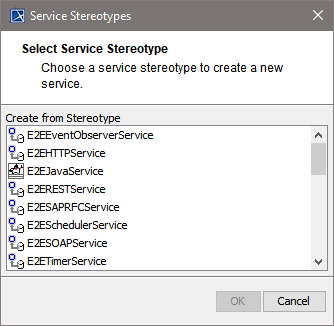 Image Modified Image Modified
| Select a service type from the list. |
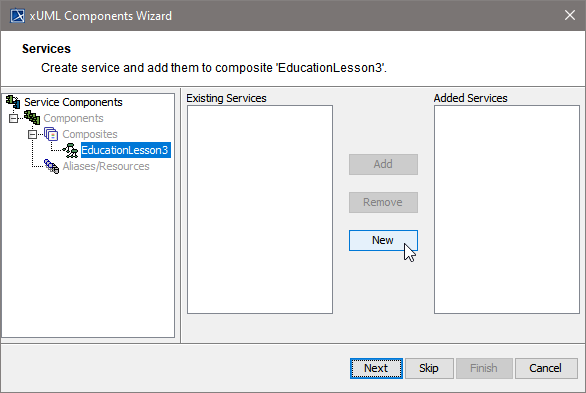 Image Modified Image Modified
| In other cases, e.g. if you want to add additional services, you can open the above dialog by clicking New on Services level of the tree. |
...
- E2EEventObserverService
- E2EHTTPService
- E2EJavaService
- E2ESAPRFCService
- E2ESchedulerService
- E2ESOAPService
- E2ETimerService
| - several ActiveMQ versions
- GlassFishMQ-4.4
- Weblogic-10.3
- WebshpereMQ-6-NoJNDI
- WebshpereMQ-7
| - XSLTProcessor
- ApacheFOP
- Saxon6 and 8
- Xalan2
- XalanTrax2
| |
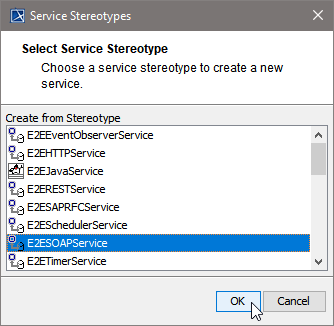 Image Modified Image Modified
| This example shows how to define a Web service. Select the service stereotype E2ESOAPService. Proceed with OK. |
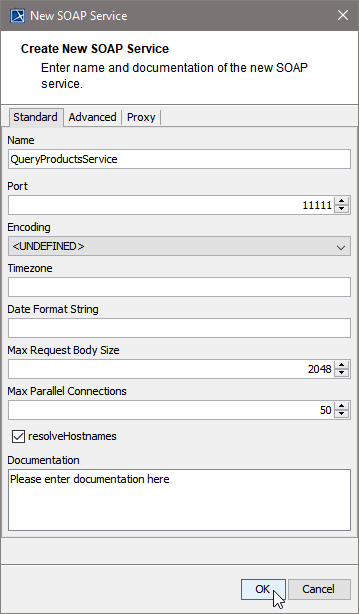 Image Modified Image Modified
| Now, customize the service artifact. | Tagged Value | Description |
|---|
Name | Assign a Name. | Port | Assign a Port, to which the SOAP service is listening (the value needs to be between 10'000 and 19'999). | | Encoding | Select an encoding. See Encoding of SOAP Operations for more information on SOAP encoding |
of xUML services. | Timezone |
| | Multiexcerpt include |
|---|
| MultiExcerptName | timezone |
|---|
| nopanel | true |
|---|
| PageWithExcerpt | SOAP Service Reference |
|---|
|
| | Date Format String |
| | Multiexcerpt include |
|---|
| MultiExcerptName | dateFormatString |
|---|
| nopanel | true |
|---|
| PageWithExcerpt | SOAP Service Reference |
|---|
|
| | Max Request Body Size | | Multiexcerpt include |
|---|
| SpaceWithExcerpt | INTERNAL |
|---|
| MultiExcerptName | max_request_body_size |
|---|
| PageWithExcerpt | INTERNAL:_bridge_excerpts |
|---|
|
| | Max Parallel Connections | Maximum number of requests that can be processed in parallel. | | resolveHostnames | Automatically resolve IP addresses to domain names. |
|
The Create New SOAP Service dialog contains two more tabs.
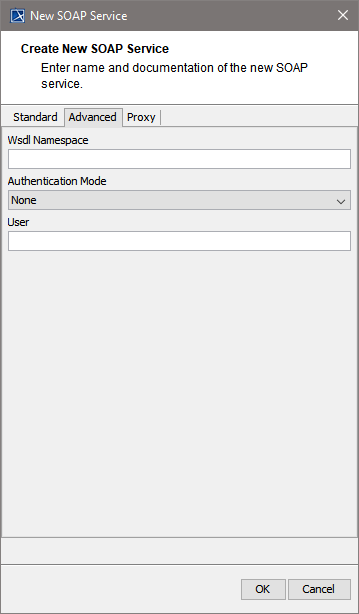 Image Modified Image Modified
| On the Advanced tab, you can specify the following settings: | Tagged Value | Description |
|---|
| Wsdl Namespace |
| | Multiexcerpt include |
|---|
| MultiExcerptName | wsdlNamespace |
|---|
| nopanel | true |
|---|
| PageWithExcerpt | SOAP Service Reference |
|---|
|
| | Authentication Mode |
| | Multiexcerpt include |
|---|
| MultiExcerptName | authenticationMode |
|---|
| nopanel | true |
|---|
| PageWithExcerpt | SOAP Service Reference |
|---|
|
| User |
| Specifies user and password for the use of HTTP Basic authentication. |
For detailed information on these tagged values refer to SOAP Service Reference. |
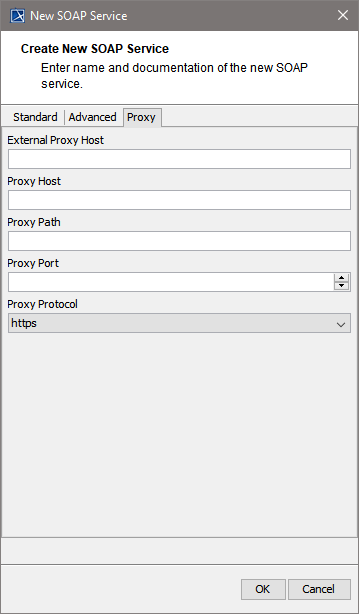 Image Modified Image Modified | On the Proxy tab, you can specify the proxy details. | Tagged Value | Description |
|---|
| External Proxy Host |
| externalProxyHost | | nopanel | true |
|---|
| PageWithExcerpt | SOAP Service Reference |
|---|
|
| | Proxy |
| proxyHost | | nopanel | true |
|---|
| PageWithExcerpt | SOAP Service Reference |
|---|
|
| Proxy |
| proxyPath | | nopanel | true |
|---|
| PageWithExcerpt | SOAP Service Reference |
|---|
|
| | Proxy Port |
| | Multiexcerpt include |
|---|
| MultiExcerptName | proxyPort |
|---|
| nopanel | true |
|---|
| PageWithExcerpt | SOAP Service Reference |
|---|
|
|
| proxyProtocol | | nopanel | true |
|---|
| PageWithExcerpt | SOAP Service Reference |
|---|
|
|
For detailed information on these tagged values refer to SOAP Service Reference. |
...
Now, in the component diagram the service component is placed within the service composite component.
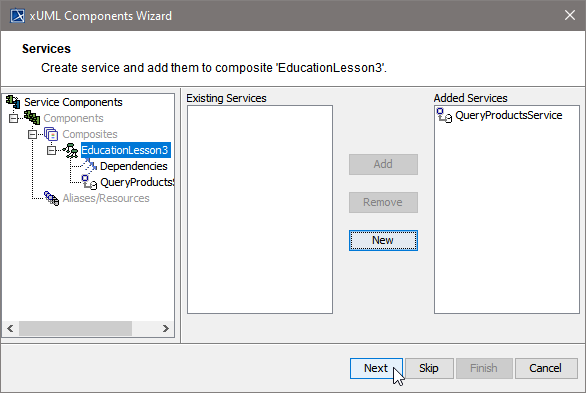 Image Modified Image Modified
| In the customization panel on the right, you will find the new service (e.g. QueryProductsService). |
Click Next to proceed.
Step 4: Defining the SOAP Service Interface
In the next step, you will define the interface of the SOAP service. Through this interface, the Web service is accessible from the outside world.
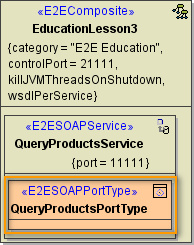
 Image Modified Image Modified
| The Components Wizard lists all port type classes on the left. Select a port type and click the button > to click Add to add the port type to the composite. |
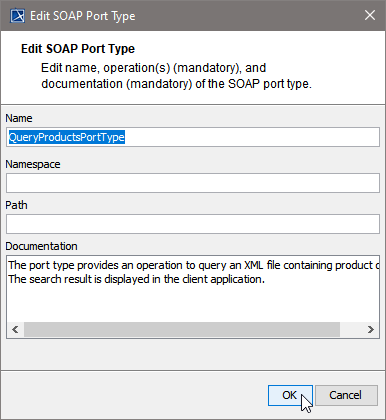 Image Modified Image Modified
| In the following dialog, assign a name to the port type or use the default name suggested. | Noteinfo |
|---|
| Special characters and blanks are not allowed for component names. |
- Provide a Namespace if necessary.
- Provide a path, if you want to make this component independent of the package structure. Without a given path, port types are identified by port type name and package URL.
Proceed with OK.
|
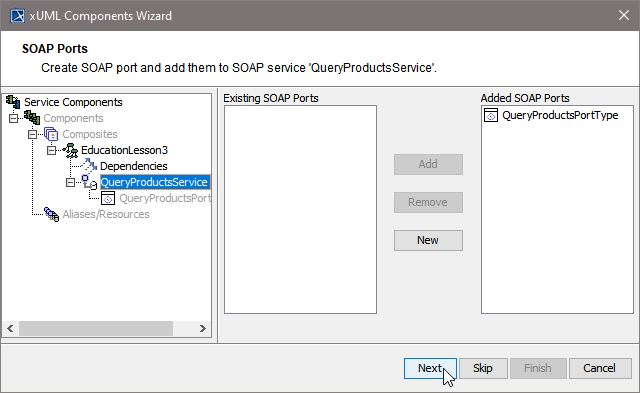 Image Modified Image Modified
| In the artifact part oft the customization panel, you will find the added port type QueryProductsPortType . As an interface can only be used once in a composite, the port type QueryProductsPortType is not displayed anymore in the SOAP Port Types list on the left. | Noteinfo |
|---|
| Each port type class (representing the interface of the SOAP service) can only be used once in a composite. |
Click Next to proceed.
|
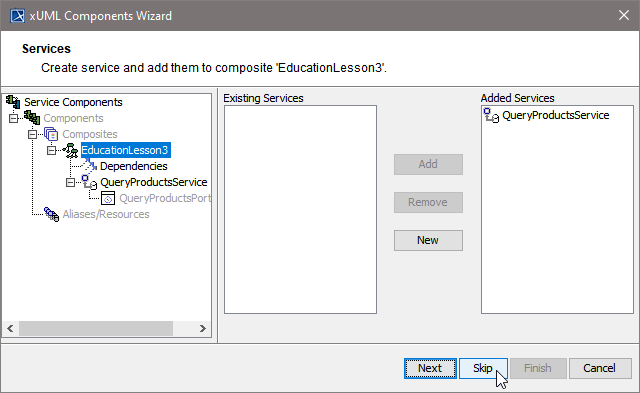 Image Modified Image Modified
| In the Customized Artifacts part of the tree panel, the xUML service is selected again , to give you the option to define further frontend services (see Defining the Frontend Service). If you do not need any further elements, click Skip. |
| For definition of Backend Services (Aliases/Resources) see below (Defining Backend Aliases). For Finishing the Components Wizard see Finishing the Components Wizard. |
Step 5: Defining Backend Aliases
In this step, backend aliases are defined. The Components Wizard provides predefined Backend Components.

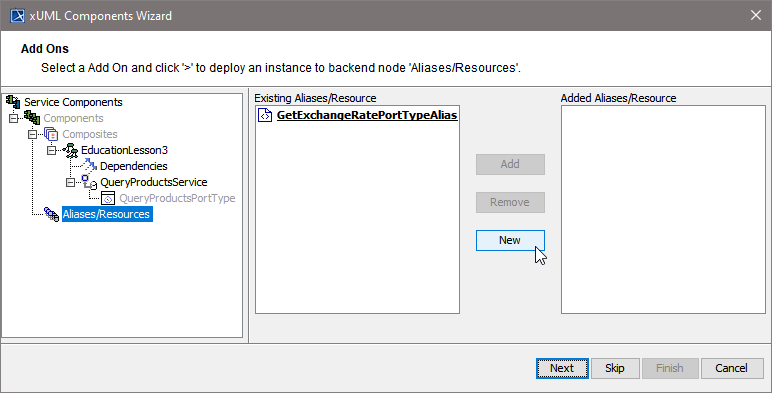 Image Modified Image Modified
| Click New to create a new backend alias ... |
 Image Modified Image Modified
| ...or select an existing alias and click > click Add to add it to the component diagram. |
...
| Choose a backend alias stereotype from the list of available stereotypes, e.g. FileSystemAlias FileAlias and click OK. |
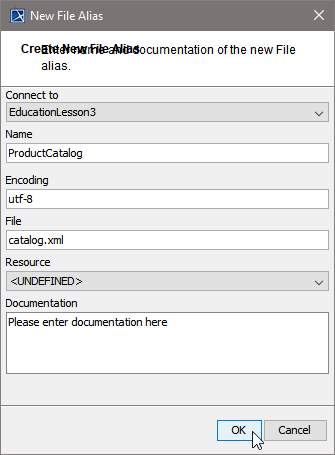 Image Modified Image Modified
| Assign a name to the alias or leave the default name suggested. Specify File Name and Path, or, if you wanted to read data from an imported resource, select the resource from the Resource drop-down box instead. Click OK. |
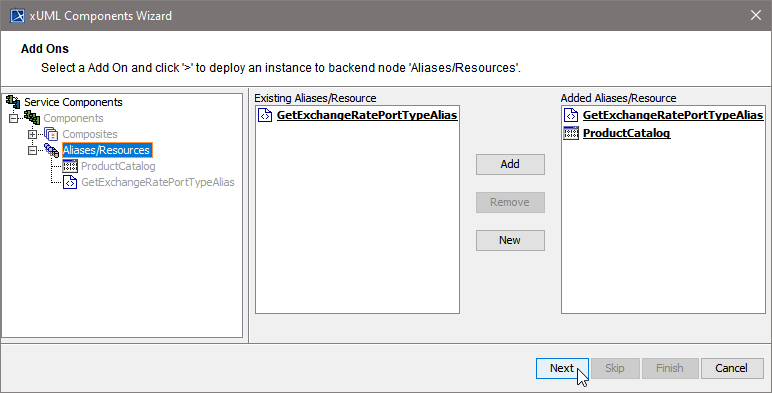 Image Modified Image Modified
| In right part oft the customization panel, you will find the new file system alias (e.g. ProductCatalog). Click Next. |
Step 6: Finishing the Components Wizard
This is the final step of the Components Wizard . You need to where you confirm to draw the component diagram. If the definitions are not complete yet, you may can select an element node in the tree panel and add further UML elements to the diagram.
...






















